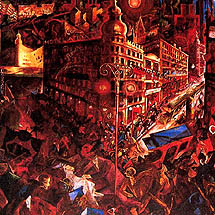| 6. Landscapes |
 |

There are natural landscapes that humans
have not changed, and there are humanised landscapes, where human
beings have transformed nature and have added their own elements.
The latter can be agricultural, urban, industrial, etc.
Urban landscapes are made up of many elements: streets, houses, cars,
people, trees, etc. All of these things contribute to shape the urban
space and create a certain perception of harmony or disorder that
is a feature of each city, or, in big cities, of the different neighbourhoods
that make it up.
|


[ enlarge image ] |
 |
| Describing. Describing is not just a way
of organising and ordering information. It is also a way of expressing
and understanding an experience, and, therefore, opens the possibility
of changing it. |
| Pictorial description of a landscape:
the window. |
Individually: |
Choose a window or balcony in
your house and draw what you see from it.
If you like, you can colour or paint it. If
you think it could be better, draw it again
as you would like it to be. |
| |
Compare the two windows and ask yourself what
you could do to improve the first window you‘ve drawn.
Could the changes you’ve drawn be made in reality? |
In groups: |
Compare the different individual drawings: of
the window as you saw it and of the window as it could be. Afterwards,
you can group the drawings according to the type of landscapes
they show. For example: exteriors of the countryside, urban
exteriors, with trees, without trees, courtyards, etc. |
| |
To draw these windows you might get some help
from the paintings Henry Matisse did of windows. Look at www.aut.edu. |
|
|
 |
 |
| Painting. Vincent van
Gogh ,1853-1890. Landscape
with House and Labourer. |
 |
Music. Dean Elliot & Big
Band, Lonesome Road. Listen to this piece of
music and look at the two landscapes in this 'Landscapes'
section: Van Gogh’s work, Landscape with House
and Labourer; and George Grosz,1893-1959, Metropolis.
To which landscape do you relate this piece? What associations
(rhythms, sounds, noises, etc.) can you make? |
 |
| Find a poem that
describes some outstanding part of a landscape: a beach,
a mountain, a lake, a river, a forest, gardens, etc. Try
to imitate the poem in your own words applying it to a
representative part of your daily landscape. |

 |
| © Grup IREF 2003, with the support of the European Commission, DG XXII (Socrates/Comenius 3.2) |
[ print ] |
|
|
|
|